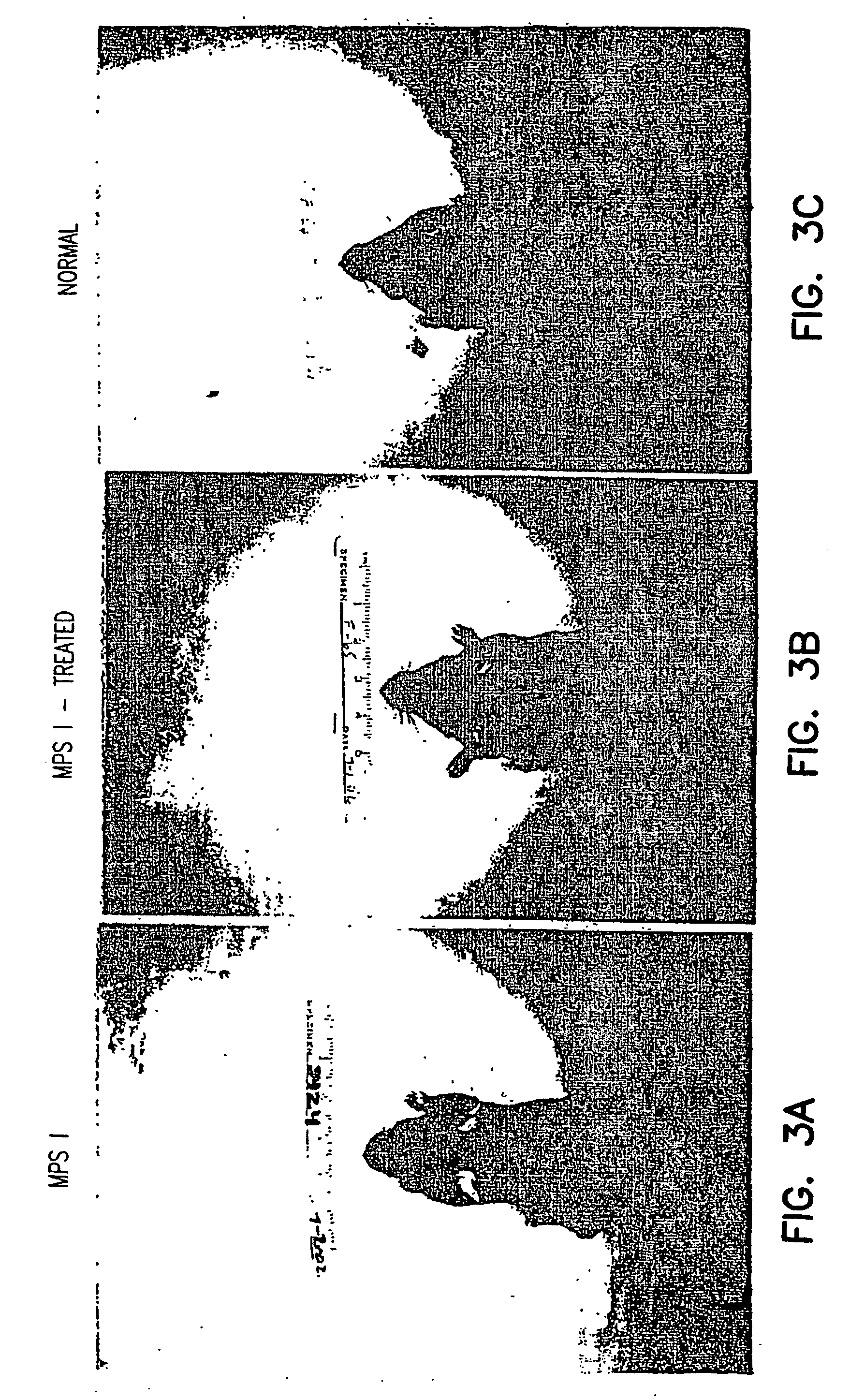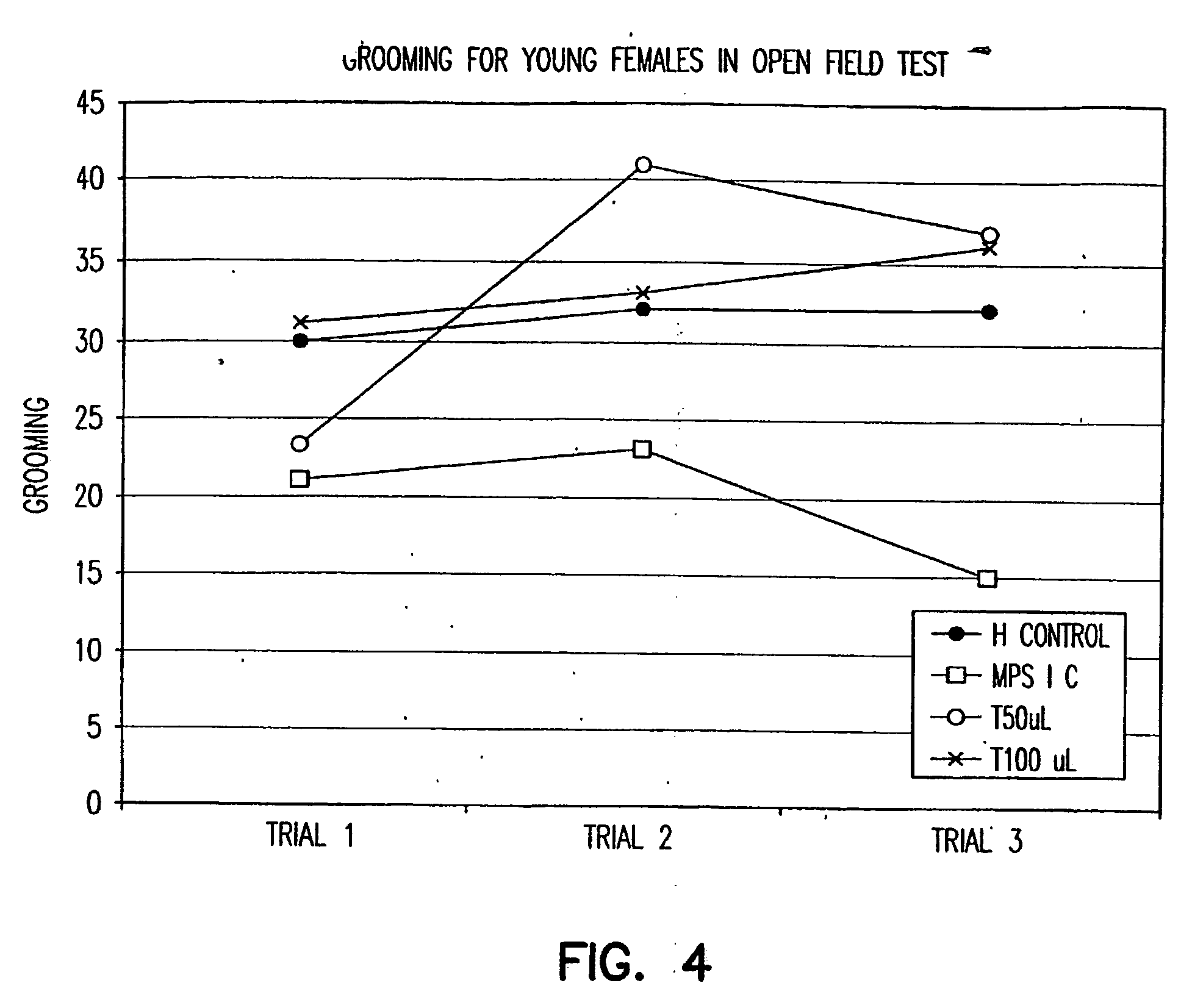Methods of using vectors to treat metabolic disorders
a metabolic disorder and vector technology, applied in the direction of animal repellents, genetic material ingredients, drug compositions, etc., can solve the problems of inability to prevent progressive mental retardation, ineffective enzyme infusion, increased morbidity and mortality, etc., to improve the efficiency of transduction, inhibit or treat lysosomal storage diseases, and improve the effect of lysosomal storag
- Summary
- Abstract
- Description
- Claims
- Application Information
AI Technical Summary
Benefits of technology
Problems solved by technology
Method used
Image
Examples
example i
Materials and Methods
[0157] Production and concentration of lentiviral vector. The lentiviral vector was generated from a first-generation tetracycline-inducible VSVG-pseudotyped lentiviral packaging cell line SODk1-CGFI (Kafri et al., 1999). The vector (HR′cmvGFP) contained a humanized red-shift GFP gene driven by a human cytomegalovirus immediate-early promoter. The vector producer cells were maintained in Dulbecco's modified Eagle's medium (DMEM) (Life Technologies, Inc., Gaithersburg, Md.) containing 10% tetracycline-free FCS (Clontech, Palo Alto, Calif.) and 0.7 μg / ml doxycycline (Sigma, St. Louis, Mo.). Induction of cells was initiated by splitting cells into polylysine (0.01% solution; Sigma) precoated plates in the absence of doxycycline. The cells were washed twice with PBS (Life Technologies Inc.) and fed daily with doxycycline-free medium containing 5 mM sodium butyrate (Sigma). Vector-containing medium was collected 3 and 4 days after induction and filtered through a 0...
example ii
[0182] Mucopolysaccharidosis type I (MPS I) is an inborn error of lysosomal glycosaminoglycan (GAG) metabolism resulting from deficiency of alpha-L-iduronidase (IDUA). While allogeneic hematopoietic stem cell (HSC) transplantation results in systemic metabolic correction, including prevention of neurologic damage, attempts to exploit Moloney murine leukemia virus vectors have failed to demonstrate the requisite qualities to merit substitution of ex vivo HSC gene therapy for allogenic HSC transplantation. Lentiviral vectors may integrate into non-dividing cells and may have broad tropism when pseudotyped with VSV-G envelope, thus potentially solving this problem.
[0183] A murine model of MPS I (kindly provided by Hong-Hua Li and Elizabeth F. Neufeld; Zheng et al., 2001) was used to evaluate transgene expression in fibroblasts from these mice. Mice were genotyped with a SYBR Green assay from which primary skin fibroblast cultures were established. Second- and third-generation HIV-1 ba...
example iii
Materials and Methods
[0188] Plasmids. The plasmid for 5B transposon expression, pT-CAGGS-GUS (transposon), was constructed as follows. A 2.3 kb fragment containing human GUSB cDNA was excised from pHUG13 (ATCC 95658) by EcoRI digestion and ligated to EcoRI sites in the poly linker in pCAGGS. The resulting expression cassette for GUSB expression included a cytomegalovirus enhancer, chicken β-actin promoter, the initial intron of the chicken β-actin gene, GUSB cDNA, and a rabbit β-globin and SV40 polyadenylation signal. This expression cassette was inserted between SspI and HindIII sites of the pT / BH transposon polylinker (FIG. 6). The SB transposase expression plasmid pCMV-SB10 has been previously described (Ivics, 1997). Pyrogen-free plasmids were used in this study and were isolated using QiaFree kit (Qiagen, City, State).
[0189] Mice. MPS VII mutant mice (B6.C-H-2bml / ByBir-gusmps) were obtained from Jackson Laboratories (Bar Harbor, Me.) and maintained in the AAALAC-accredited S...
PUM
| Property | Measurement | Unit |
|---|---|---|
| molecular weight | aaaaa | aaaaa |
| thickness | aaaaa | aaaaa |
| volume | aaaaa | aaaaa |
Abstract
Description
Claims
Application Information
 Login to View More
Login to View More - R&D
- Intellectual Property
- Life Sciences
- Materials
- Tech Scout
- Unparalleled Data Quality
- Higher Quality Content
- 60% Fewer Hallucinations
Browse by: Latest US Patents, China's latest patents, Technical Efficacy Thesaurus, Application Domain, Technology Topic, Popular Technical Reports.
© 2025 PatSnap. All rights reserved.Legal|Privacy policy|Modern Slavery Act Transparency Statement|Sitemap|About US| Contact US: help@patsnap.com



